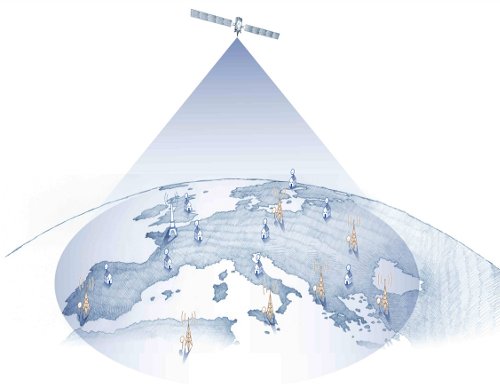Talking to Earth
DID YOU KNOW?
A single geostationary satellite can communicate to millions of users at the same time over one third of the earth's surface in a quarter of a second.
Coverage
Satellites are an obvious means to 'talk to earth' for numerous applications because one satellite can cover almost 1/3 of Earth's surface, offering a reach far more extensive than any terrestrial network. Its coverage or ‘footprint’ is always international, and depending on its distance from earth, may be ‘regional’.

The example of broadcasting (point to multi-point communications) demonstrates well the advantage of satellite coverage. Once uploaded, video or audio content can be sent to millions at the same time, so three geostationary satellites can 'see & serve' the entire globe.
Spectrum
Communications satellites 'talk' to users on a planet 36,000km away. Their signals are delivered using frequencies that are part of the electromagnetic spectrum. The distance these satellite signals have to travel mean they are 'delicate' when they reach the earth and easily interfered with. On the good side, satellite signals measure only picowatts & do not therefore have any major impact on the natural environment.
Certain frequency bands have been dedicated to satellite use for many decades by the International Telecommunications Uni on. Different frequency bands are suitable for different climate conditions and types of markets. They are labeled with letters for homogenous global identification. Lower frequencies (L-, S- and C-bands) are less affected by the heavy rainfall in parts of Africa/ Asia/ Latin America and can serve wide areas of the globe at a time. Higher frequencies (Ku-band) allow smaller antennas to be used on the ground (as seen in Western Europe/ the US) with more focused service beams on regions or sub-regional areas.
| S-DAB | L-BAND | S-BAND | C-BAND | Ku-BAND | Ka-BAND |
| 1.467 GHz to 1.492 GHz |
1.518 GHz to 1.675 GHz |
1.97 GHz to 2.69 GHz |
3.4 GHz to 7.025 GHz |
10.7 GHz to 14.5 GHz |
17.3 GHz to 30 GHz |
| Satellite Audio Broadcasting to fixed and mobile units |
Civilian Mobile-Satellite Services (two-way) | Satellite television & radio broadcasting to mobiles + two-way mobile services |
Fixed-Satellite television, & data services (including broadcasting) |
Fixed-Satellite television & data services (including broadcasting) |
Fixed-Satellite television & data services (including broadcasting) |
A satellite is constructed from the outset to transmit via a clearly identified frequency band(s) and this cannot be changed after launch. Click here to read more about spectrum management.
Communications satellites 'talk' to users on a planet 36,000km away. Their signals are delivered using frequencies that are part of the electromagnetic spectrum. The distance these satellite signals have to travel mean they are 'delicate' when they reach the earth and easily interfered with. On the good side, satellite signals measure only picowatts & do not therefore have any major impact on the natural environment.
1.467 GHz
to 1.492 GHz